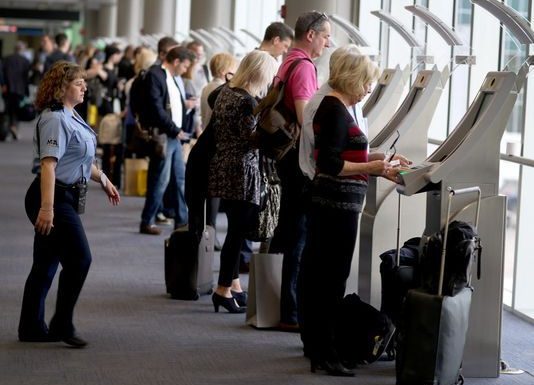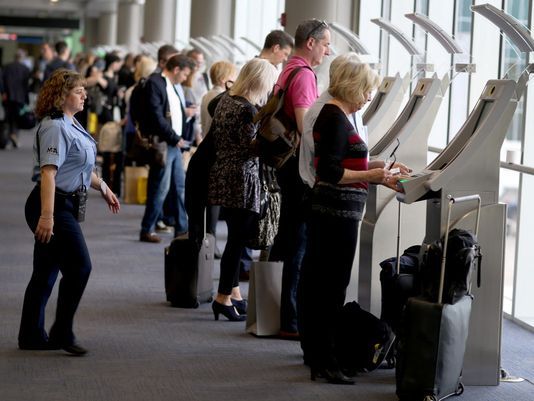

WASHINGTON – About 700,000 fewer international tourists arrived in the U.S. during the first three months of the year compared to last year, according to Commerce Department figures, a decline anticipated and feared by the travel industry.
The steepest drops were from the Middle East and Africa, regions that sent about one-fourth fewer visitors to the U.S. than two years ago, according to preliminary figures from the department’s National Travel and Tourism Office.
While those regions send a relatively small number of tourists to the U.S., European arrivals were down 10% to 2.6 million visitors, down nearly 300,000 during January, February and March. Arrivals from Mexico were down 7% to 3.9 million visitors, also nearly 300,000 during the period.
Overall, the 15.8 million international tourists during the first quarter were down 4%, or 697,791 visitors. The decline represented nearly $2.7 billion in reduced spending, according to an estimate by Tourism Economics of Wayne, Pa., which analyzes travel data widely used in the industry.
“It means that we are seeing substantial declines in international travel,” said Adam Sacks, president of Tourism Economics. “Our concerns are being realized.
The Commerce Department issued a statement that Secretary Wilbur Ross is committed to power of travel and the economic benefit it provides. Ross met Wednesday with his Travel and Tourism Advisory Board to discuss ways to support the industry, and talks are continuing.
“The Trump Administration is unequivocally committed to ensuring that the U.S. continues its globally competitive quality visitor experience while also ensuring the safety of both our residents and our guests,” the statement said.
The travel industry warned of an anticipated drop in inbound tourism after President Trump’s “America first” rhetoric in his inauguration speech, his call for a wall along the border with Mexico and his proposal for a temporary travel ban for citizens of six Muslim-majority countries. Trump and other administration officials say the wall and travel ban are important security measures.
Federal courts halted the travel ban for citizens from Iran, Libya, Somalia, Sudan, Syria and Yemen, while awaiting a decision in the Supreme Court. Congress is debating funding for the wall.
But industry officials said travel choices are flexible enough that policies for a specific region can ripple around the world.
“The international travel market is ultra-competitive, and the U.S. is falling behind,” said Roger Dow, CEO of the U.S. Travel Association, which represents groups including hotels, restaurants and attractions.
For example, the U.S. dropped two slots in international rankings of desirable tourist destinations even before the administration’s travel policies, according to the World Economic Forum’s Travel and Tourism Competitiveness Report in April.
Japan and the United Kingdom each leapt ahead of the U.S., which ranked sixth among tourist-friendly destinations.
“We are going to be left behind” without changes, said Patricia Rojas-Ungár, vice president for government affairs at the U.S. Travel Association. “This pie continues to grow. Our slice is getting smaller if we don’t go after it.”
To combat anticipated declines in tourism, city and state organizations began their own travel advertising earlier this year. Discover Los Angeles began spending millions in April advertising in Mexico, Canada, China, Australia and the United Kingdom. NYC & Co. spent $3 million to welcome visitors from the United Kingdom, Mexico, Germany and Spain.
Gauging the cost of declines in foreign tourists is contentious.
According to Commerce Department’s Bureau of Economic Analysis, international travel spending in the U.S. is up 0.7% to nearly $78 billion during the first six months of the year. More spending on airfare and lodgings were factors in the slight growth, according to the agency.
But Tourism Economics projected a $2.7 billion loss in travel spending from 697,791 fewer visitors, largely from steep declines in spending from Europeans and Mexicans. The declines were slightly offset by gains from Canadian visitors, after a two-year decline from that country.
Tourism Economics had previously projected U.S. tourism could lose $18 billion this year and next, from spending that would have been expected. Besides the travel ban and immigration policies affecting other countries, surveys among Europeans showed anger regarding the U.S. withdrawal from the Paris climate accord and perceived antagonism toward the European Union and the North Atlantic Treaty Organization.
“There’s plenty of material that could negatively affect the Europeans’ view of America, and their willingness to travel,” Sacks said. “Europeans can travel elsewhere or they can delay trips incredibly easily.”
Dow urged the Trump administration to promote tourism through programs such as Brand USA, which is funded through visa fees and markets the U.S. abroad as a tourist destination, or the visa-waiver program.
But Trump proposed in his budget to eliminate Brand USA and shift the funding to Customs and Border Protection. Congressional panels that make spending decisions have so far ignored the request.
Tightening visa security is at the heart of Trump’s travel-ban proposals, to make it harder for terrorists to reach the U.S. But the visa-waiver program allows citizens of 38 countries, including most of Europe, to visit the U.S. without visas after providing more information about travelers and sharing intelligence about security threats.
While the administration reviews visa policies, the U.S. Travel Association is encouraging the carrot of the visa-waiver program rather than the stick of making visas harder to obtain.
“What we’re concerned about, in contrast, is an approach that says that we’re going to limit visas and punish countries that don’t meet our standards,” Rojas-Ungár said. “That ‘stick’ approach, we think, is not the right approach because at the end of a day, if a country refuses, you may be stuck with a security system that is not up to par.”
courtesy= usatoday.com

